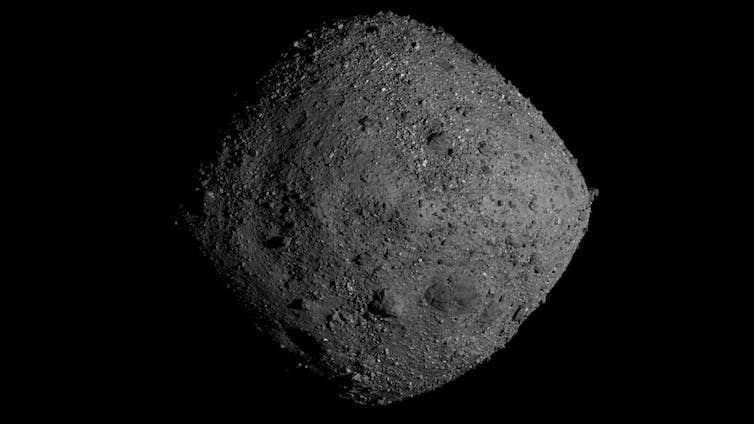Around 15 years ago, I was on a European Space Agency (Esa) committee, looking at Esa’s strategy for proposed forthcoming space missions. Under consideration was a mission to an asteroid. Over dinner, one of the committee members, an astrophysicist, quizzed me on why we needed to visit one of these objects.
“Nasa has already been to one and the Japanese Space Agency to another. Why do you need to go to another one? They’re all the same aren’t they, just lumps of rock?” My deliberately less-than-polite response was: “Why do astronomers keep wanting to launch more telescopes into space to look at stars? They’re all the same aren’t they, just balls of burning gas?” Our meal continued in frosty silence.
The misconception that asteroids are “just lumps of rock” doesn’t stand up to scrutiny, given the rich harvest of information about asteroid diversity that has come from studying meteorites. Meteorites have taught us about the origin and evolution of the Solar System.
We can measure the ages of meteorites and identify the volatiles – water- and carbon-containing chemicals – that some contain. Volatiles are important for understanding how the building blocks of life were delivered to Earth.
But there are gaps in our knowledge, so we need to study samples directly taken from asteroids – in part because meteorites are often contaminated with compounds from Earth’s environment. This means we can’t always be sure that the volatiles in them came from the asteroid itself, or from Earth.
We also don’t fully understand the relationship of specific meteorite types to different classes of asteroids. This affects our understanding of how volatiles were distributed in the early Solar System and therefore what types of objects could have delivered life’s building blocks to Earth. Hence the need for sample return missions.
On Sunday 24 September, a Nasa spacecraft called Osiris-Rex will fly past Earth and release a capsule containing a haul of dust and rock, which it collected from the surface of the asteroid Bennu in 2020. Under the watching eyes of nervous scientists, the capsule will parachute down to a test range in Utah, where it will be retrieved and taken to a sample-curation facility in Houston.
A rich heritage
The previous missions mentioned by my astrophysicist colleague were Nasa’s Near-Shoemaker spacecraft, which operated from 1996 to 2001, and the Japanese space agency’s (Jaxa) Hayabusa mission, which lasted from 2003 to 2005.
Hayabusa brought a few milligrams of material to Earth from the asteroid Itokawa. This allowed us, for the first time, to measure an asteroid’s age –- an important first step in understanding relationships between asteroids and meteorites.
The two most recent asteroid missions are Jaxa’s Hayabusa2 mission to the asteroid Ryugu and Nasa’s Osiris-Rex mission to Bennu. The missions both orbited carbonaceous asteroids, which are rich in volatiles. The orbiting spacecraft helped confirm that Ryugu and Bennu are both water-rich asteroids, with abundant clay and carbonate minerals.
The asteroids have very low densities, suggesting they are objects called “rubble piles”. These contain significant amounts of empty space beneath the surface. Rubble piles formed from debris thrown into space when their bigger parent bodies were hit by another object. The rubble eventually came together to form an asteroid of its own.
Watery history
Results from analysis of samples from Ryugu were published in December 2021. They showed that the Ryugu material is very similar in composition to what we call CI meteorites. This is important because CI-related materials are extremely fragile and easily weathered.
As a result, few survive their passage through the Earth’s atmosphere. Now that we can link these rare meteorites more definitively to the class of asteroids Ryugu belongs to, we can expand our understanding of the processes that asteroids went through as they evolved.
In the past, temperatures on some asteroids were just high enough for liquid water to exist. The reaction of the original minerals with water transformed them into more complex mixtures. Evidence suggests the parent asteroid for Ryugu was altered by water between two million and five million years after the Solar System formed.
An important aim of Hayabusa2 was to analyse organics (carbon-containing chemicals) in the sample. There’s overlap between organics and volatiles. Both categories include compounds that could have been important for the origin of life.
Nasa’s Scientific Visualization Studio
There were around 20,000 species (types) of organic compound present in the Ryugu material. This opened our eyes to the sheer complexity of organic compounds in primitive asteroids.
So what’s still left to learn from Bennu? For a start, Osiris-Rex observed bright regions on Bennu’s surface. These were interpreted as thick veins of the mineral carbonate.
These were not seen on Ryugu’s surface, although individual grains were found during lab analysis of the samples. This could suggest that alteration by water took place under different conditions on Bennu.
If the ages of alteration by water are different between Ryugu and Bennu, it could mean one of the asteroids underwent a longer process of alteration. This would suggest that their parent bodies formed in different parts of the Solar System.
Like Ryugu, Bennu is very dark. Analysis of Ryugu from orbit suggested that a process called space weathering may have helped darken and dehydrate the asteroid’s surface. However, lab analysis of the Ryugu sample revealed the presence of clay minerals, showing that water was in fact abundant on the asteroid. If the same effect is observed for Bennu, there are implications for the search for water on asteroids.
Bennu is recognised as a potentially hazardous asteroid, meaning there is a one in 3,000 chance of it hitting us in 150-200 years’ time.
By the time the global community of planetary scientists has analysed all the available material from Bennu, it is unlikely that any aspect of its formation, evolution and orbital history, composition and components will be unknown, allowing an effective “Earth
rescue” mission to be launched.

